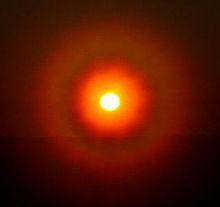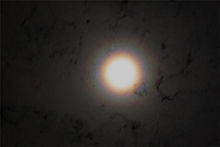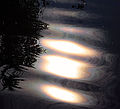Corona (optical phenomenon)
- Corona (optical phenomenon)
-

A solar corona soon after sunrise

A solar corona over the North Tower of the Golden Gate Bridge
In meteorology, a corona is produced by the diffraction of light from either the Sun or the Moon by individual small water droplets (and sometimes tiny ice crystals) of a cloud.
The corona consists of small number of concentric colored rings around the celestial object and a central bright aureole. The angular size of the corona depends on the diameters of the cloud droplets - small droplets produce bright coronae. Coronae differ from haloes in that the latter are formed by refraction (rather than diffraction) from comparatively large rather than small ice crystals. Reddish colors always occupy the outer part of a corona's ring. (This is an atmospheric Airy disc.)
See also
External links
Gallery
-
-
Reflection of solar corona
-
-
-
Categories: - Atmospheric optical phenomena
- Optics stubs
- Atmospheric science stubs
Wikimedia Foundation.
2010.
Look at other dictionaries:
Glory (optical phenomenon) — A glory is an optical phenomenon appearing much like an iconic Saint s halo about the head of the observer which is produced by light backscattered (a combination of diffraction, reflection and refraction) towards its source by a cloud of… … Wikipedia
Halo (optical phenomenon) — A halo (unicode|ἅλως; also known as a nimbus, icebow or Gloriole) is an optical phenomenon that appears near or around the Sun or Moon, and sometimes near other strong light sources such as street lights. There are many types of optical halos,… … Wikipedia
Sun — This article is about the star. For other uses, see Sun (disambiguation). The Sun … Wikipedia
Photoelectric effect — The photoelectric effect is a quantum electronic phenomenon in which electrons are emitted from matter after the absorption of energy from electromagnetic radiation such as x rays or visible light.cite book | title = Physics for Scientists… … Wikipedia
Volcanic ash — consists of small tephra, which are bits of pulverized rock and glass created by volcanic eruptions,United States Geological Survey. [http://volcanoes.usgs.gov/Hazards/What/Tephra/tephra.html Tephra: Volcanic Rock and Glass Fragments.] Retrieved… … Wikipedia
List of meteorology topics — This is a list of meteorology topics. The terms relate to meteorology, the interdisciplinary scientific study of the atmosphere that focuses on weather processes and forecasting. (see also: List of meteorological phenomena)AlphanumericTOC… … Wikipedia
cosmos — /koz meuhs, mohs/, n., pl. cosmos, cosmoses for 2, 4. 1. the world or universe regarded as an orderly, harmonious system. 2. a complete, orderly, harmonious system. 3. order; harmony. 4. any composite plant of the genus Cosmos, of tropical… … Universalium
light — light1 lightful, adj. lightfully, adv. /luyt/, n., adj., lighter, lightest, v., lighted or lit, lighting. n. 1. something that makes things visible or affords illumination: All colors depend on light. 2. Physics … Universalium
Mathematics and Physical Sciences — ▪ 2003 Introduction Mathematics Mathematics in 2002 was marked by two discoveries in number theory. The first may have practical implications; the second satisfied a 150 year old curiosity. Computer scientist Manindra Agrawal of the… … Universalium
Business and Industry Review — ▪ 1999 Introduction Overview Annual Average Rates of Growth of Manufacturing Output, 1980 97, Table Pattern of Output, 1994 97, Table Index Numbers of Production, Employment, and Productivity in Manufacturing Industries, Table (For Annual… … Universalium








